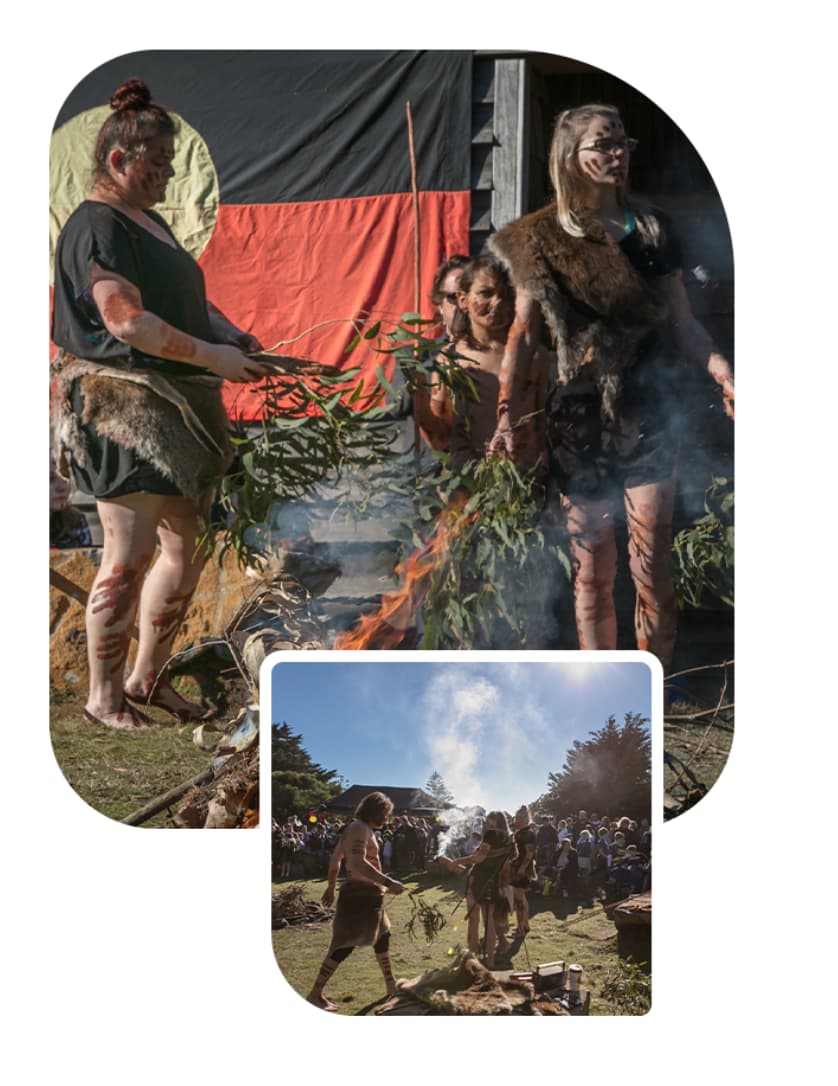A Brief History

WHO WE ARE
This region, referred to as North West Tasmania, is the home today of thousands of Aboriginal people, from many Tasmanian Aboriginal and mainland Australian Aboriginal families.
The local Aboriginal organisation is Six Rivers Aboriginal Corporation based in Latrobe. Some of the Aboriginal names for the Mersey river are Warwoolernunne or Warkerruneno, Weeleetetter, Tollumenergully or Tallumenergully.
A brief history of the Aboriginal community of the Devonport/Latrobe region
The original people of this northern region included the Punnilerpanner people from around Panatana (Port Sorell), the Pallittorre from Lartitickitheker (Quamby Bluff), the Noeteeler at Ningherner or Parteenno (Hampshire Hills) and the Plairhekehillerplue at Emu Bluff.
British invasion/colonisation began in the 1790s, and one result is that there are no known direct descendants of these specific Aboriginal groups to survive into the twentieth century.
In this region the incursion of the Van Diemen’s Land Company from the 1820s, and the colonists’ stock keepers’ range extending along critical river / valley pathway corridors, plus pastoralists large local land grants eg: North Down, fatally impacted on the local Aboriginal population.
The broader Aboriginal community of Tasmania today maintain cultural, custodian responsibilities for the entire island.




The plaque on the memorial to Dalrymple and Thomas Johnson (1970) located on Railton rd, south of Latrobe, adjacent to the original site of their home SHERWOOD HALL (relocated in the mid 1990s to Bells Parade, Latrobe and open to the public).
DALRYMPLE JOHNSON
This region was the final home base for Dalrymple Johnson.
Dalrymple Johnson,(AKA Dolly, nee Briggs) was born.c.1808 on Little Kangaroo Island, Furneaux group (see obituary TROVE). Dalrymple died in 1864 in Latrobe, Tasmania.
Baptised ‘Dalrymple’ in Port Dalrymple in 1814 (by Rev. Knopwood) Dalrymple was a daughter of Trawlwoolway woman Woretemoeteyenner (Woretemoeteyenner sister’s were Wapperty and Wottecowidger) and Dalrymple’s father was George Briggs, a ‘sealer, originally from Bedfordshire . Dalrymple was a grandddaughter of Mannalargenna, a sister of John Briggs (later of Coranderrk, Victoria) and to Eliza Briggs and Mary Briggs, who passed away aged in their early twenties.
Dalrymple and her (convict) husband Thomas Johnson lived here from the mid 1840s when they moved from Dunorlan, to initially lease Frogmore, on the Mersey River, from the Moriarty family, near to what was to become the township of Latrobe. The Johnson’s raised a large family, with 10 surviving children, they built the first church and school in the district. They also built two inns, a coal mine, and a timber mill that exported to South Australia.
Dalrymple and her ancestors’ maternal home country was Tebrikunna, the far north east of Tasmania, but surrender to, capture and killing by British colonists led, from the early 1800s to Trawlwoolway people’s exile from Country. In Dalrymple’s case, she lived since her childhood in Country that was not her own, initially as a servant around Launceston and Norfolk Plains, then in the early 1830s near Quamby Bluff, and then Perth in Tasmania.
Since 1845 a majority of Dalrymple and Thomas’ children, and their descendants, remain in this district, emanating from Latrobe/East Devonport, now numbering in their thousands.
To read more about Dalrymple’s mother’s experiences in Van Diemen’s Land, and subsequently at Wybalenna Aboriginal settlement on Flinders Island, and of her eventual freedom, to live the remainder of her life with Dalrymple, who petitioned the Government for her release to her family in 1841 visit the below link.
RECENT ARTICLES
Tiagarra Come Together BBQ
In the last week of November 2015 there were two fantastic developments
On 20 November 2015 the WALK FOR TIAGARRA event was held. A large group of Aboriginal and non Aboriginal supporters of Tiagarra met at the skatepark and walked up to TIAGARRA together in solidarity for the reopening of TIAGARRA. Many thanks to TasTAFE...
One dollar to transfer TIAGARRA ownership
24 November 2015, Baz Ruddick, The Advocate
